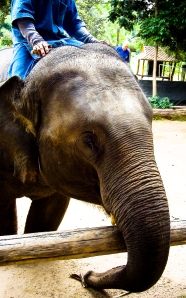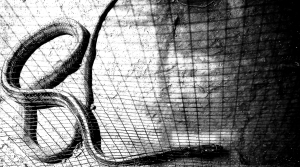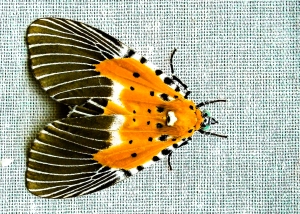So, with the hustle and bustle involved in moving me from Shanghai to the Sanmen nuclear site where Michael works, I have fallen way behind on the blog. Therefore, I am going to quickly detail our last day in Thailand, letting the pictures and videos do most of the talking, and then start up again with my China posts. So here goes!
Elephants
We spent the last day and a half of our trip in Chiang Mai, Thailand’s second largest city. Robert, our insect guide from the Punjen Hideaway, was traveling there to trap moths in the city’s hilly outskirts and graciously offered to give us a lift so we didn’t have to mess with the train. He also agreed to stop at the Thai Elephant Conservation Center in Lampang so Michael and I could see the elephant show and go for an elephant ride.
I had seen elephants before, of course, but always in a zoo or circus and always in a shamefully unnatural climate. I was excited to see an Asian elephant in Asia, not behind bars or in a traveling sideshow.
The Thai Elephant Conservation Center is a huge compound of forests, ponds, and trails. The Center’s vets and mahouts (traditional Thai elephant trainers) take care of more than 50 Asian elephants, including those of Thailand’s king and queen.
It was an hour before the next show, so Michael and I went for a 30-minute elephant ride around the grounds. Our elephant was a heavy, thick-tusked female. She hardly seemed to notice when we scrambled over her mountainous shoulders into the riding basket buckled to her back. The elephant’s mahout sat bareback in front of us just behind the elephant’s head. He spoke to her conversationally in Thai as she walked us out of the gate.
The old girl bore the three of us easily and took her time wading through the Center’s ponds, crashing along the forest trails, and clomping down the paved road. You really get a sense of how big these animals are when you’re sitting atop one. The ground seems forever below you and when the elephant walks, its massive shoulder blades shift the riding basket up and down, producing an effect like airplane turbulence.
After the ride, we bid farewell to our mighty mount and her mahout and walked over to the elephant arena to watch the show. The show was part living history, part gimmick. The amazing elephants demonstrated their beast-of-burden history in Thailand, where the country’s logging industry traditionally used the animals to move and manipulate felled trees and logs, by deftly pushing, stacking, and carrying, logs in the arena. But the elephants also bowed to the audience, played instruments (drums, a xylophone, and a harmonica), danced (unfortunately to Fergie’s “My Humps”), and used their dexterous trunks to wield paint-laden brushes with which they painted sixth-grade-worthy pictures of trees and flowers. It was all very impressive, if a little circusy. However, only the stoniest-hearted could leave the Center without a new appreciation for these mighty jungle kings.
Snakes
Michael and I had failed to spot any dangerous, one-bite-will-kill-you-dead snakes while we were in Ban Pin. So, naturally, when we got to Chiang Mai, we told our driver to take us to the best cobra show in town. The place he recommended was a rambling collection of tin-roofed buildings prefaced by sun-faded billboards that advertised the joint’s snake handlers as, “The Best in The Business” and claimed that they had helped “train the cast of Rambo 4.”
Our driver walked us in, grabbed a newspaper from the front desk, plopped himself into a chair near the door, and began to read. Michael and I wandered around the showroom, which was little more than a cement floor lined with a few rows of wire snake cages, some potted plants, and a round, sunken show arena. Sunlight filtered down through the netted ceiling in bright squares. We peeked eagerly into the cages’ dark recesses and caught shadowy glimpses of jumping snakes, mangrove snakes, and the fearsomely beautiful monocled cobra.
We finished looking at the caged snakes and wandered over to the arena’s bamboo bleachers to wait for the show to begin. The cramped arena was lined with pilling green felt, and somewhere speakers thrummed with generically ethnic music that grew more frenzied as the handlers walked into the ring and readied themselves for snakes and spectacle. Our expectations were low, but the show turned out to be hugely entertaining: The handlers took turns sparing athletically with varyingly venomous snakes. The announcer ooo’d and awe’d along with audience and said things like, “Don’t worry, it takes at least two hours for monocled cobra venom to kill a human. By the way, the hospital is two and half hours from here…”
None of the snakes, which included a giant boa constrictor, two rat snakes, a jumping snake, two monocled cobras, and a king cobra (the longest venomous snake in the world), was defanged; a point the handlers drove home when they wrapped the riled serpents around the necks of the most willing whiteys in the audience (a.k.a. me an Michael) and shoved the snake’s open jaws in our face so we could give the ornery ophids a kiss.
The handlers were lithe and comical as they spun, parried, and danced around the watchful snakes. The cobras were especially poised. They stood tall, hoods concavely flared like the head of a spoon, above tightly coiled tails. The snake’s shining eyes followed the handlers’ every antagonizing move and when the men’s gamboling stopped in front of us, the snakes seemed to be looking directly at Michael and me, daring us to move or twitch or breathe. It was a marvelous feeling.
When the handler’s got too close or too still, the king cobras struck confidently at the men’s abdomens, which were level with the snakes concentrated gaze. The handlers’ aim, according to the announcer, was to hypnotize or distract the snake’s attention so that the men could kiss the animal’s head before the handler’s mesmeric spell was broken and the snake moved it’s attention from the man’s twitching foot or wiggling finger to his face. This took some time and was clearly not 100 percent effective as many of the handlers had fingers missing or large, shiny purple scars on their hands and feet. The handlers stood close to the alert snakes, locked eyes with them, and bent slowly forward toward the serpents’ scaly heads until something about the animals would change, a subtle twitch, a slight muscle contraction, a cock of the head that said, “I know what you are trying to do, and it’s not going to work,” and the handlers would back away and try again.
After the senior handler had kissed his cobra, he invited audience members to walk into the ring and have someone snap a picture of us kneeling in front of the still vigilant and erect snakes. I would love to say I was more eager than Michael about the whole thing, but then, the snake didn’t strike at me and did take a full on lunge at Michael [See video] He still gets chills when he thinks about it.
Tigers
The last animal attraction we saw that day in Chiang Mai was the tiger conservation and rehabilitation center.
The center raises and rehabilitates sick and injured tigers, so the animals there are very tame and used to people. This post is getting long despite my previous promise of brevity so I will just say that is was pretty cool. The tigers were large, apparently free of sedative drugs—though the largest ones seemed house-cat drowsy—and still had all their teeth and claws. Once you bought tickets, you were allowed to go into the tiger’s enclosures in small groups and take photos with the animals as the played and slept. It was pretty unbelievable. We had to sign a waiver, but we were actually allowed to lie down next to the largest the tigers and take pictures with our heads on their bellies.
The younger tigers were very playful, as cats are, with string, bits of wood and toy balls, but were rather uninterested in us. Considering that my head could easily fit into the animals’ yawning, toothy mouths, their incuriosity was a good thing, no? Their astounding banded, orange fur is is one of nature’s best examples of disruptive coloration and, up close, the black bands are nearly patent in their glossy sable. Tigers are truly special animals and I think it’s pretty cool that there is a place that allows you to interact with the animals. I don’t know if it’s safe, exactly. But it’s pretty cool.
























